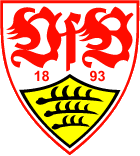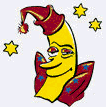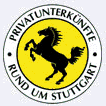
• Giovanni Trappatoni: “Football is Ding, Dang, Dong. There is not just Ding.”
Stuttgart and the VfB and an Italian coach and at the front of the storm a Dane – the German Football League would be poorer without the VfB. The “Reds” meet in the Gottlieb-Daimler-Stadion for stadium sausage and plastic cup beer, they suffer, they rejoice, fan riots are unheard of here. The Swabians may “bruddeln” (grumble into their beards) but at the bottom of his heart he is an optimist and is happy for the winner even if it isn’t the VfB for once.
Link: VfB Stuttgart
Club portrait:
In 1893 some football loving Swabians founded the „Fußballverein Stuttgart“. Four years later, Gottlieb Daimler has not only brought his first engines to the start of production, the enthusiasm for football expands there too and the „Kronen-Club Cannstatt” is born. In 1912 the two clubs decide to join a team representing the whole city, the „Verein für Bewegungsspiele 1893 e.V. Stuttgart“. Under their first full time coach, an international one from England called Tom Hanney, the Swabians become champion of Baden-Württemberg already in 1926. Also their second coach Dr. Kovacs, from Hungary, achieves this title in 1931. In 1933 the Neckarstadion, today the Gottlieb-Daimler-Stadion, becomes the official playing ground of the club. The first German Championship duel is lost after being defeated by the FC Schalke 04 in Köln despite four goals. The final score was 6:4. But in 1950 it happens: In front of the gigantic backdrop of 96000 people in the Berlin Olympia stadium, Stuttgart beat the Kickers from Offenbach 2:1 with goals by Läpple and Bürer. Just 10000 people are witness when the Swabians can repeat this success two years later against the 1.FC Saarbrücken. In this heyday, two cup victories follow in 1954 and 1958 before the kick-off of the German Football League in which the VfB is represented in the first phase. With the start of a new league begins a phase characterised by a relative unsuccessfulness for the VfB Stuttgart. The club may be a set player in the league for 12 years but cannot bring a title back to the Neckar. Furthermore, the Swabians rely too much on their home advantage. While the Neckarstadion in 1975 is chosen by the local press as “impregnable fortress”, there is one landslide victory after the other abroad – for the opponents. The new president Gerhard Mayer-Vorfelder faces tough times. At the end of the season is the relegation. Stuttgart says goodbye to the German League for two years. This does not derogate the fan culture, on the contrary: After rising once again in 1977, the VfB achieves a record cut in the following year with 54000 spectators, which would only be beaten at the end of the 90s by the BVB from Dortmund. At the end of the season is the vice championship. The early 80s are significantly formed by a pair of brothers from Stuttgart. Bernd and Karlheinz Förster, the “whacker with the angel face”, together call the shots with the young striker talent Karl Allgöwer. The brothers consequentially take part in the World Cup in Spain, which – despite the second place – does not become the hoped for career peak of the two because of the “Non-attack-pact” in the scandal game against Austria. Before the season of 1983/84 the VfB engages a young defence player from the local rivals Stuttgarter Kickers. The talented defender played all 34 games of the season and showed an impeccable performance. At the end of the season Stuttgart is all the way at the top and there is a new name in the game cards of the national team: Guido Buchwald. With his reliability, he helps the VfB to continually present itself as co-favourite for the title. With him the Swabians reach the UEFA-Cup final in 1989 and Germany becomes World Champion in 1990, thanks to his outstanding performance in the World Cup final. Because he reduces the Argentinean football god, or at least his hand, to complete inactivity, he receives the nickname “Diego” Buchwald. In 1992 the league undergoes its most exciting season final ever – perhaps with the exception of the “Herzen-Meisterschaft” of Schalke. On the last day of playing, Frankfurt, Stuttgart and Dortmund are equal on points at the top of the league table. Shortly before the end, the BVB, the only one ahead, looks like the certain champion. Stuttgart captain Sammer is sent off in the 79th minute, shortly thereafter Günther Schäfer scrapes the ball off of their own goal line with an artistic manoeuvre. In the 86th minute, Guido Buchwald achieves the decisive goal with a header to make it 2:1. Dortmund cries, Stuttgart celebrates the fourth German Championship in total. The Swabians win the DFB cup in 1997 with the “magic triangle” Bobic, Balakov and Elber, then the trio breaks up when Elber follows the call of the Bavarians. Bobic soon after changes to Dortmund. Under new coach Felix Magath and his co Balakov, the only one to remain with the club, a new team is put together which in 2002 qualifies for the Champions League for the first time with an average age of under 25. The VfB has a new image, they are now the “young wild ones”. Matthias Sammer as coach cannot follow previous successes after Magath changes to the Bavarians, the Swabian mentality remains a mystery to him. Then the drumbeat for the season 2005/2006: Trappatoni is coming! And if he kicks off, then even the Swabians gawp. Let’s look forward to some interesting games!







